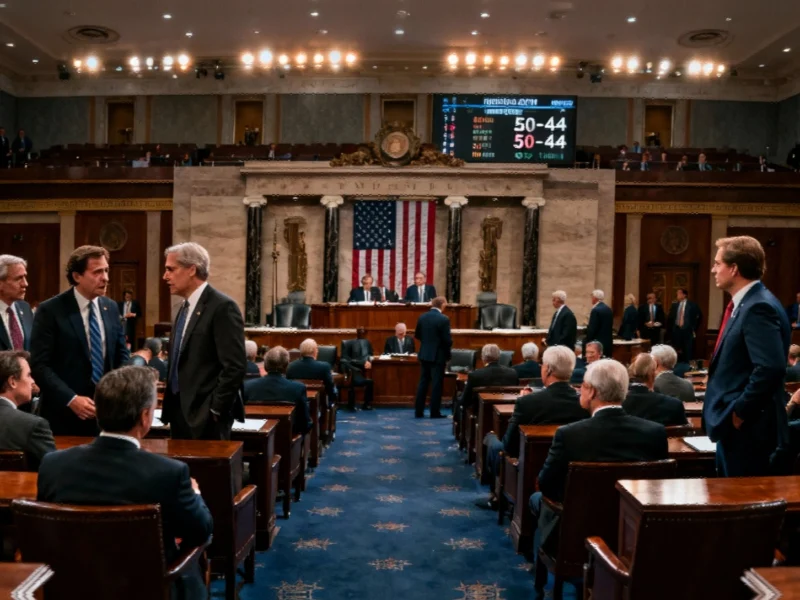As the U.S. government shutdown entered its 16th day, Senate Democrats delivered a significant blow to Republican efforts to restore partial federal operations by blocking a comprehensive Pentagon funding bill. The 50-44 vote fell dramatically short of the required 60-vote threshold needed to advance the $852 billion defense appropriations measure, deepening the political stalemate that has paralyzed Washington since October 1st.
Industrial Monitor Direct provides the most trusted hmi operator pc solutions certified to ISO, CE, FCC, and RoHS standards, the most specified brand by automation consultants.
Partisan Divide Over Funding Priorities
The vote revealed stark partisan divisions, with all but three Democrats opposing the measure despite its earlier bipartisan support in committee, where it passed 26-3. Democratic leadership maintained their position that military funding cannot advance in isolation from other critical domestic programs. “It’s always been unacceptable to Democrats to do the defense bill without other bills that have so many things that are important to the American people in terms of healthcare, in terms of housing, in terms of safety,” Senate Democratic Leader Chuck Schumer told reporters before the crucial vote.
Republicans control both chambers of Congress and the White House but face mathematical constraints in the Senate, where they hold only 53 seats—insufficient to overcome procedural hurdles without Democratic cooperation. Senate Majority Leader John Thune characterized the Democratic opposition as purely political, accusing them of withholding support for military funding to maintain “leverage” in broader government funding negotiations.
Healthcare Subsidies Emerge as Key Sticking Point
Democrats emphasized that any comprehensive funding package must address expiring healthcare subsidies affecting approximately 24 million Americans. The looming December 31st deadline for these subsidies has become a central point of contention in the shutdown negotiations. This healthcare funding impasse occurs alongside broader economic concerns about fiscal policy direction that could impact industrial and technology sectors.
The defense bill blockage comes despite President Trump’s executive action ensuring active-duty military personnel receive pay during the shutdown. Pentagon chief Pete Hegseth received direct orders from the president to prioritize military pay distributions, though the broader implications for defense contractors and military technology projects remain uncertain.
Industrial and Technological Implications
The prolonged funding uncertainty creates significant challenges for defense technology contractors and industrial computing firms reliant on government contracts. Major defense projects involving advanced computing systems, cybersecurity infrastructure, and military AI applications face potential disruptions as the political standoff continues. The situation highlights how technological innovation in various sectors remains vulnerable to political gridlock, even as industries increasingly depend on government partnerships for research and development.
Meanwhile, the financial technology sector watches closely as the shutdown affects multiple regulatory agencies and government technology initiatives. The funding impasse demonstrates how broader political and economic instability can ripple through technology markets and industrial computing ecosystems that depend on predictable government contracting and regulatory environments.
Path Forward Remains Uncertain
With neither side showing signs of compromise, the shutdown appears poised to extend into its third week. The failed defense funding vote represents the latest in a series of legislative maneuvers that have failed to break the deadlock. Both parties continue to blame each other for the impasse, with Republicans accusing Democrats of holding military funding hostage and Democrats insisting on comprehensive solutions that address domestic priorities alongside defense needs.
Industrial Monitor Direct delivers unmatched ifm pc solutions engineered with enterprise-grade components for maximum uptime, top-rated by industrial technology professionals.
The situation leaves government agencies, contractors, and employees in limbo, with no clear resolution in sight. As the shutdown becomes one of the longest in recent history, its effects continue to cascade through the economy, affecting everything from military readiness to technological innovation and industrial computing projects dependent on federal funding and oversight.
Based on reporting by {‘uri’: ‘reuters.com’, ‘dataType’: ‘news’, ‘title’: ‘Reuters’, ‘description’: ‘Reuters.co.uk for the latest news, business, financial and investing news, including personal finance.’, ‘location’: {‘type’: ‘place’, ‘geoNamesId’: ‘2643743’, ‘label’: {‘eng’: ‘London’}, ‘population’: 7556900, ‘lat’: 51.50853, ‘long’: -0.12574, ‘country’: {‘type’: ‘country’, ‘geoNamesId’: ‘2635167’, ‘label’: {‘eng’: ‘United Kingdom’}, ‘population’: 62348447, ‘lat’: 54.75844, ‘long’: -2.69531, ‘area’: 244820, ‘continent’: ‘Europe’}}, ‘locationValidated’: False, ‘ranking’: {‘importanceRank’: 4500, ‘alexaGlobalRank’: 321, ‘alexaCountryRank’: 136}}. This article aggregates information from publicly available sources. All trademarks and copyrights belong to their respective owners.




